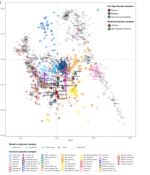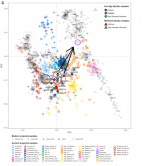Jovialis
Advisor
- Messages
- 9,309
- Reaction score
- 5,858
- Points
- 113
- Ethnic group
- Italian
- Y-DNA haplogroup
- R-PF7566 (R-Y227216)
- mtDNA haplogroup
- H6a1b7
I would accept that bet, even 1.000 and more � if being real, because will never, ever, be the explanation. There was a series of immigrations after that time, starting with the Greek colonisation, the slave trade, free and slave workers in the Latifundia, general migration from the Greek speaking Hellenistic world. This will explain it.
And in the end you will see that modern Southern Italians being somewhat shifted North again from Late Antiquity to High Medieval times, because of Northern and Balkan migrants, as few as they might have been, but still significant. The MENA shift will peak in very Late Imperial times, not any time before or afterwards.
And yes, the situation will be different for different parts of Italia, because not all regions had the same agricultural and economic system, not all had the same source of flow of slaves, the same ratio of free vs. unfree, of locals vs. migrants. Every region, even in the South, might be looked at on its own, with later balancing and homogenisation effects erasing some of the regional differences.
Good to see you agree now
Yes, it will be South Eastern Urnfield groups from the Channelled Ware horizon, especially Belegis II-Gava (I would link Incrusted Ware to it also, which is even more clearly correlated with E-V13) which spread E-V13 primarily, with the core group being Daco-Thracian, but various Pannonian-Illyrian groups being heavily influenced too. However, if you look at how they migrated Southward, its noticeable, even from the purely archaeological standpoint, that the Channelled Ware groups did not reach and have the same impact further South, which is especially true in the Western Balkans. So areas like the Vojvodina were an early hub and centre on the Balkans, but South from there, they had not the impact initially and even more, they didn't reach the coastal regions of the Adriatic, but stayed rather inland, along the river systems and especially the Danube.
The expansion of E-V13 South was happening, imho, actually earlier to the East, where they quickly rushed to the Aegean, whereas in the West, we deal with slow and secondary expansions, from the direct North, from areas like Vojvodina. Even if it was not Belegis-Gava, but an even later migration, which I don't think, but which is possible, they usually followed the same path. The Dalmatian coast was not the first to be reached by expansions following the more Northern river systems usually.
What's even more, being in search for a reason for the settlement in Italia, a good reason is usually being unable to colonise territories closer on land and being blocked or even under pressure by the neighbours. The usual shifts in the region went, usually, from North -> South. There are exceptions to those rule, but usually, that was the direction it was going.
Check this article and the map on p. 175, which shows how the related groups expanded very roughly, with their centres:
http://www.austriaca.at/0xc1aa5576 0x002debf3.pdf
I think these new results won't close the case, but they make any alternative to the Northern Urnfield spread even more likely than they already were.
Well you are already wrong about Latifundia, because as Vagnari showed, they were composed of locals.



